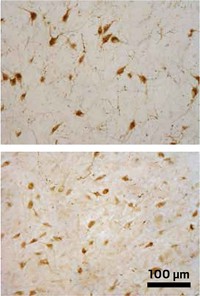Advertisement
Grab your lab coat. Let's get started
Welcome!
Welcome!
Create an account below to get 6 C&EN articles per month, receive newsletters and more - all free.
It seems this is your first time logging in online. Please enter the following information to continue.
As an ACS member you automatically get access to this site. All we need is few more details to create your reading experience.
Not you? Sign in with a different account.
Not you? Sign in with a different account.
ERROR 1
ERROR 1
ERROR 2
ERROR 2
ERROR 2
ERROR 2
ERROR 2
Password and Confirm password must match.
If you have an ACS member number, please enter it here so we can link this account to your membership. (optional)
ERROR 2
ACS values your privacy. By submitting your information, you are gaining access to C&EN and subscribing to our weekly newsletter. We use the information you provide to make your reading experience better, and we will never sell your data to third party members.
Neuroscience
Testosterone alters isoflurane sensitivity
Mouse research suggests a mechanism for controversial sex difference in response to anesthesia
by Laurel Oldach
January 18, 2024

Not many drugs are as widely used yet poorly understood as anesthetics. “We’ve used them for over a century, but nobody understands how they work,” says Alex Proekt, an anesthesiologist and neuroscientist at the University of Pennsylvania. Researchers in Proekt’s lab recently published work on another wrinkle besides mechanism of action: that sex hormone differences in the brain may drive differences in sensitivity to anesthesia (Proc. Natl. Acad. Sci. U.S.A. 2024, DOI: 10.1073/pnas.2312913120) .
Researchers have sometimes reported sex differences in how people recover from anesthesia—specifically, that men regain consciousness more slowly than women. But the phenomenon is not always observed, making it controversial. In addition, clinical studies of anesthesia are challenging, and have historically focused on men.
While studying how consciousness comes back online as an anesthetic drug called isoflurane wears off, Penn postdoctoral researcher Andrzej Wasilczuk observed that anesthetized female mice are more likely to retain certain reflexes, go under more slowly, and wake up more quickly than male mice. By testing castrated male mice and female mice with ovaries removed, Wasilczuk and colleagues determined that testosterone drove the observed reawakening differences. Castrated male mice, like female mice, were more likely to right themselves from a vulnerable belly-up position while anesthetized. Treatment with testosterone or a downstream metabolite, estradiol, made the castrated mice more sensitive to the effects of isoflurane. Conversely, blocking the enzyme that converts testosterone to estradiol made uncastrated male mice less sensitive.
Using a whole-brain activity imaging technique, the researchers found sex differences in activity in part of the hypothalamus, a brain region with roles in both sleep and the endocrine system.
The scientists revisited human data from a study of reacquiring consciousness after isoflurane treatment and found that men were less likely than women in that trial to respond to stimuli, like an instruction to squeeze a hand. The difference is undetectable using electroencephalography (EEG), a noninvasive measure of brain activity, which anesthetists use to monitor unconsciousness. Proekt says this lack of detection is because the hypothalamus is deep in the brain—too deep to detect using the external electrodes that EEG relies on. That may be part of why any sex difference has been so hard to identify for certain in people.
According to Margaret Sedensky, a University of Washington anesthesiologist who studies anesthetic mechanisms, the work is interesting, but the mechanistic relationships will need to be examined further. Although the mouse studies used a drug concentration the researchers confirmed was the same in males and females, it’s possible that in humans, attributes correlated with sex could cause different amounts of drug to reach the brain or affect the rate of drug metabolism, she says in an email. In addition, the study focused on a single inhaled anesthetic, whereas human patients anesthetized for surgery usually receive a mixture of painkillers and multiple anesthetics.
Fortunately, becoming aware during anesthesia is quite rare. But the research suggests it might happen more often in people with lower testosterone, such as cisgender women.





Join the conversation
Contact the reporter
Submit a Letter to the Editor for publication
Engage with us on Twitter